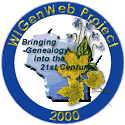

 |
Green Lake County Wisconsin USGenWeb |
 |
 |
Kingston is the south-west corner town of the county. It is bounded north by the town of Marquette, east by Manchester, south by Columbia county and east by Adams county. The face of the town is much broken, presenting a rolling aspect, with one noted rise, Mt. Moriah, the highest (p. 277) land in the county, which stands like sentinel, breasting the storms that sweep its plains, a landmark and a guide for miles around, stretching eastward as if to protect the valley lying at its base. The town is well watered and raises much hay. The pasturage is good and it may in time become somewhat noted as a dairy town.
Settlements.
The actual settlement of this town began in 1846 when George Bentley, Isaac Fuller, A.D.C. Knowlton, Anson Babcock, Harry Dart, Isaac Hewett, O.W. Bow and Thomas Mosley came and located their lands. The first white man who located in the town had come as early as 1828, however. This was Poquette, and some say he was a French half-breed. He was an Indian trader and government agent. He married a squaw and was killed by Indians in some quarrel. He is said to have been a man of massive proportions, being six feet and six inches in height and weighing nearly 300 pounds. After his death the post at Bellefontaine, as the locality was called, was broken up. His widow married Judge Wadsworth of Portage.
Organization.
Early Events.
The first school was taught by Mr. Bow in 1846 and 1847. His neighbors turned out and built fence for him in return for his services in behalf of education. The first church was the Baptist, organized in 1846, with Elder Sargent as pastor, the second was the Methodist in 1847, Elder Stone as pastor. The first death of a white person was that of a young emigrant girl who fell from a wagon near Mr. Bow's and was killed. This town was the scene of a terrible murder of an innocent boy, the particulars of which are given elsewhere.
Village of Kingston
This village, like Markesan and Manchester, is on Grand River, which furnishes power for a flouring mill here. It is pleasantly situated upon elevated land. It was platted in 1855 by Edward H.S. Dart, and Fox and Millard's addition was laid out in the same year. Eight miles east of Marquette, the nearest railway station and eighteen miles from Fox Lake, the nearest banking point; the place contains a flouring mill, two churches, a school and about three hundred inhabitants.
J. H. Dart made the first settlement here, and Mr. Kilmer came in 1846 and built the first frame house. The first general store was opened soon afterward by E.R. Stevens in a building covered with split logs, so poor a roof that it is said the merchant had, at times, to set up nights, when it rained and catch the dripping water in pans to prevent it soaking his goods. The first tavern in the village was kept by D.M. Phelps. The nearest grist mill in he early days was at Watertown; but the inhabitants of this place were not exempted from the unfair rule which obtained at the grist mills nearer by and consequently often had to go to West Troy, one hundred miles distant, with oxen, to get their flouring done.
A grist mill was guilt here in 1818 by Drummond & Jewett and was later owned by J.E. Millard & Bros. The local miller now is Henry Pettit. The water power here is said to be the best on the river. Thirty years ago Kingston had a population of 900, about three times its present population. The business interests and features of the village at that time are said to have been a carding mill, a wagon shop, a saw mill, a tavern, three blacksmith shops, two wagon shops, one paint ship, two tailor shops, two shoe shops, two tin shops, one cooper shop, one cabinet shop, one drug store, one jewelry store, four general stores, one grocery, a leather store, a meat market, two school houses, a church and a postoffice. The Baptists owned the church. Services were held also by the Methodists and the Episcopalians. The church building later became the property of the Methodists. It was built in 1855.
A depressing evil here at one time was the choice of the place as the headquarters of a gang of thieves, counterfeiters and incendiary rioters who occasionally varied the pleasant monotony of (p. 278) their business avocations by the perpetration of other quite serious crimes. In the fall of 1868 a fire destroyed five of the best store buildings, and is thought to be the work of part of this gang. Later some of them were arrested for offenses against the United States laws and this fact and other good influences brought about the overthrow and the departure of most of their numbers.
E.G. Boynton, George S. Greenleaf, Henry Vinz and Henry Volkman are merchants here at this time. Dr. James Lawn is the resident physician. W.M. Chapel is a resident lawyer. James M. Chapel is postmaster. The Kingston Spy is a four-page paper published by W.W. Williams and devoted to local and general interests.
Newton Wilson Post, No. 28, G.A.R.
The charter for this post was granted
March 18, 1888. The charter members were as follows: E. C. Brayton, J.M. Chapel,
G.A. Joslen, William W. Hunter, Thomas Gunderson, John Milligan, Fred Koh, C.P.
Hewitt, William Garner, Frank Knight, H.R. Price, August Gelanman, George Brayton.
The first officers were E.C. Brayton, Com.; J.M. Chapel. S.V.C.; George Brayton,
J.V.C.; G.A. Joslen, Quar. And Adjt.; John Milligan, Surg.; H.R. Price, O.D.;
Frank Knight, O.G.; C.P. Hewitt, Chap. The present officers are J.M. Chapel,
Com.; E.C. Brayton, S.V.C.; William Garner, J.V.C.; A.J. Joslen,Quar. And Adjt.;
H.R. Price, O.D.; John Milligan, Surg.; William W. Hunter, Chap.; Frank Knight,
O.G. The post now numbers twenty-five members.
Back to GreenLakeCoWI Home Page
GreenLakeCoWI Coordinator: MAKtranscriber WIGenWeb State Coordinator: Tina Vickery WIGenWeb Assistant State Coordinator: Marcia Ann Kuehl
Complication Copyright 1996-Present - by The WIGenWeb Project Team